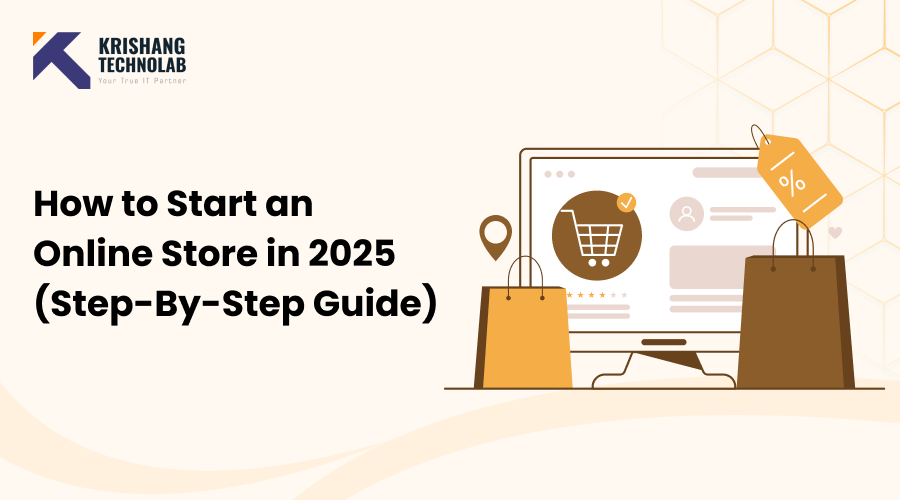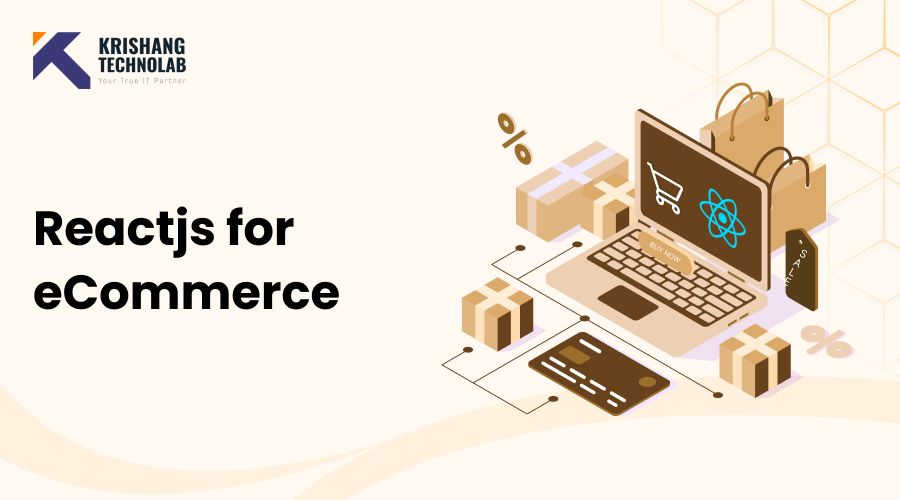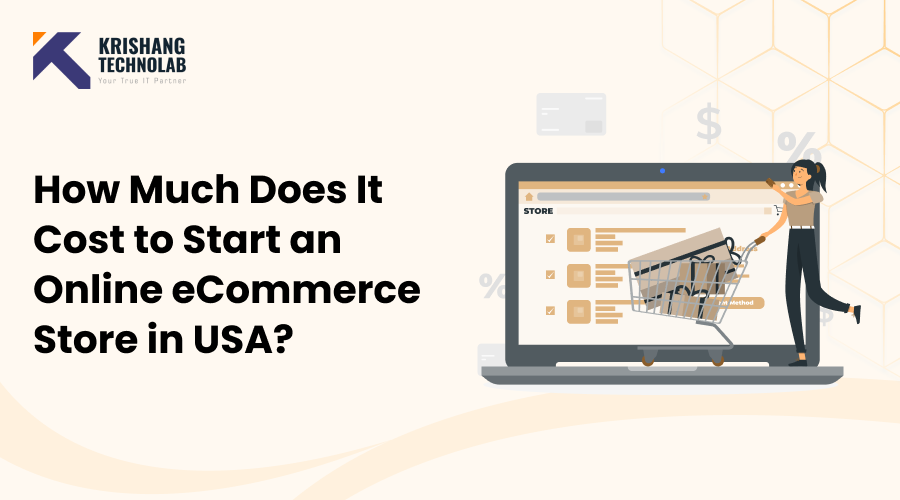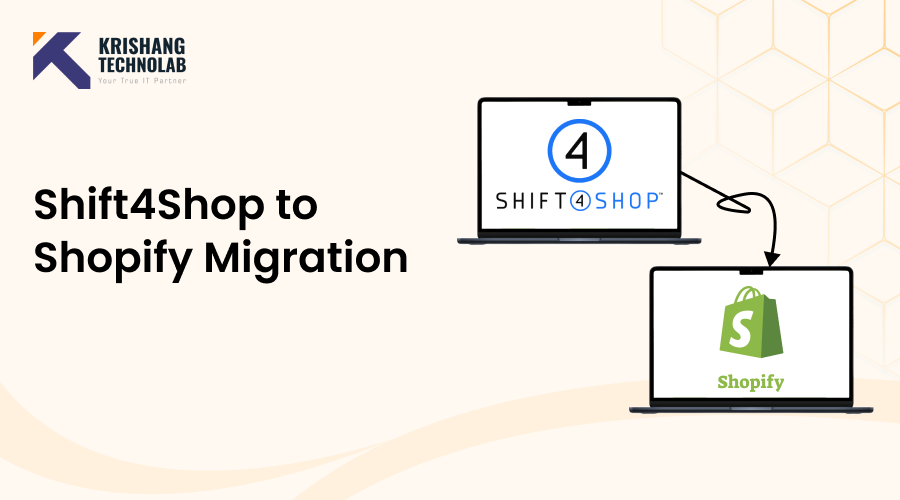Quick Overview: Starting an online store in 2025 is a great way to sell products and reach customers worldwide. You we’ll learn how to start an online store, focus on picking the right products, building a simple website, and using easy marketing ideas to make your first sales.
To be successful well in the competitive e-commerce company field, you need to plan ahead if you want to start an online store. Identify your target audience, choose products, and select a scalable platform like Shopify. Make your store easy to use and search engine friendly, and make sure your brand is powerful. To gain customers’ trust, make sure you follow the law, offer various payment and shipping alternatives, and make your policies clear.
Before you launch, test your site and get people excited with marketing initiatives. After the launch, use influencer partnerships, content marketing, and retargeting advertisements to draw people to your site. Use analytics, customer input, and market trends to keep improving your store all the time. Your store can do well in the ever-changing world of online store development if you work hard.
What is e-commerce business
E-commerce enterprises sell things or services online, which means that customers may shop, pay, and get their goods without having to go to a store. They run their businesses using online stores, secure payment gateways, and delivery systems, and they often reach people all over the world. B2C (like Amazon), B2B (like Alibaba), and C2C (like eBay) are all examples of e-commerce models. They are essential to modern commerce, offering convenience, variety, and affordability.
Importance of an e-commerce website
An e-commerce website is crucial for modern businesses, enabling global access 24/7. It allows businesses to showcase products, process payments, and offer personalized customer interactions. E-commerce sites cut down on costs, let you grow your business, and give you data that can help you make better decisions. They meet the needs of evolving customer habits by offering convenience, variety, and competitive prices. In the digital age, they are vital for business growth.
Why start an online store in 2025?
It’s a good idea to open an online store in 2025 because e-commerce is still growing because of changes in how people shop and new technologies. Businesses can access customers all over the world, stay open 24 hours a day, seven days a week, and save money on overhead costs compared to traditional retail.
It’s easier than ever to set up and grow an online business thanks to new technologies, safe payment channels, and easy-to-use platforms like Shopify. Also, tailored marketing and analytics help firms make their products better and give customers a better experience. In 2025, an e-commerce business isn’t just an option; it’s a great approach to grow a business that can compete and grow.
Also Read : How Much Does It Cost to Start an Online eCommerce Store in USA?
How to Start an Online Store Step by Step Guidance
To build an online store from scratch, you need to make a good plan, pick the proper products, and choose a platform that is easy to use. Hire a Shopify developer can help you create an e-commerce website from scratch that is visually appealing, secure, and provides a seamless user experience. Branding, design, marketing, and optimization are all important steps in developing a successful e-commerce firm in the highly competitive digital marketplace.
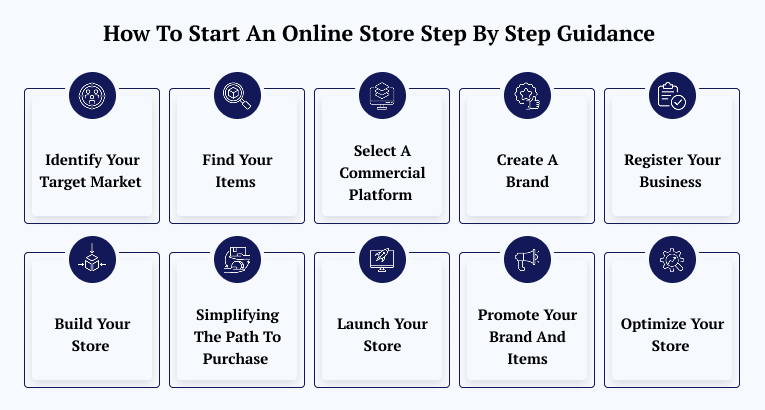
Step 1 : Identify Your Target Market
Your e-commerce business will only be successful if you know who your target market is. Go beyond demographics like age, income, and location to explore interests, values, and challenges. To really get to know your audience, use tools like Google Analytics and social media analytics, join forums, look at your competitors, and do surveys. Divide your market into groups so you can run targeted advertising, and change them as trends and preferences change. Understanding your audience deeply enables you to create experiences that foster loyalty and repeat visits.
Criteria for a Winning Business
When beginning a business or picking a niche, it’s important to use an organized method to figure out how likely it is to be successful. Three important factors. Profitability, Searchability, and Passion give you a complete way to judge whether your idea is feasible and will last.
- Profitability means that your business can make enough money to pay its bills and make a profit, which is good for your finances.
- Searchability is all about how easy it is for people to find your products and services online, which is very important in today’s digital-first environment.
- Passion draws on your own passion, which helps you stay motivated and committed to your idea over time.
By evaluating these factors, you can identify ideas that align with your skills and interests while also having strong potential for success in a competitive market. You may use these things to establish a business that is both gratifying and strong.
Step 2 : Find your items
Picking the proper products for your online business is important for growing your brand and making money. Use tools like Google Trends or Amazon Best Sellers to find out what people want and what is popular in the market. Decide on your product sourcing method, whether it’s creating your own items, dropshipping, purchasing in bulk, or private labeling. Concentrate on niche products that align with your brand and address specific customer needs effectively.
To make sure you have a good profit margin, figure out your costs, such as production, shipping, and marketing. Before you make a lot of them, test small batches to see how people respond and get feedback. To make your e-commerce business successful in the long run, focus on quality to develop trust, loyalty, and good ratings.
Top Strategies to Discover Winning Products
Finding the correct product to sell is an important step in starting a successful online business. This is a strategy-based way to find the best items:
- Analyze Market Trends
Use resources like Google Trends, Amazon Best Sellers, and social media sites to find products and categories that are becoming more popular.
- Solve Customer Pain Points
Find common difficulties that your target market has and look for goods that will help. For ideas, talk to people in forums, social media groups, and online communities.
- Evaluate Competitors
Look at what popular stores in your niche are selling and see if there are ways to make your products better or stand out from the rest.
- Test Products Before Committing
Run tiny ad campaigns or sell a small amount of stock to see how much interest there is and get feedback. This will help you make sure there is enough demand before you expand.
Step 3 : Select a commercial platform
For your online store to be successful, you need to choose the correct online shopping platform. Find a platform that is easy to use, can grow with your demands, and has a lot of features. Shopify is a great choice because it has flexible templates, a huge app ecosystem, and trustworthy hosting. WooCommerce and Shopify are two leading options, each catering to different business needs and preferences.
Consider your budget, technical expertise, and essential features like payment gateways, SEO tools, and mobile optimization. Make sure that third-party apps for marketing, inventory, and analytics work well with each other. A versatile platform makes it easier for your e-commerce business to grow smoothly.
Also Read : Why Shopify is the Best E-Commerce Platform
Step 4 : Create a Brand: Define Your Brand Identity
Your brand is the most important component of your online store. It tells people what you are like and sets you apart from other stores. To make a strong, memorable brand, you need to be creative, strategic, and real. This is how to do it:
1. Define Your Brand Identity
Figure out what your mission, vision, and values are. Think about what your firm stands for and how you want people to feel about your brand. Understanding your target audience is crucial, as a clear identity fosters a stronger connection between your brand and customers.
2. Develop a Memorable Brand Name and Logo
A good brand name is one that is unique, easy to remember, and represents your firm. Add a logo that looks good and shows who you are. Getting an expert to design your logo will make sure it makes a lasting impact and generates trust.
3. Establish a Brand Voice
Your brand voice is the way you talk to your audience, including the tone and style you utilize. Consistency in tone across all platforms fosters trust and familiarity, whether it’s nice and casual or professional and informed. Your brand voice, whether casual or professional, should resonate with your audience’s preferences while genuinely reflecting your business’s character and values.
4. Choose a Cohesive Visual Style
Pictures are a big part of how people remember a brand. Choose a color scheme, font, and design style that all go together and fit with your brand values. For a consistent look, use these elements on your website, packaging, and marketing materials.
5. Craft Your Brand Story
A good brand story makes your firm feel more like a person. Tell us what inspired you to go on this adventure and what principles guide you. A good story helps people connect with your brand on an emotional level, which makes it easier for them to remember it.
6. Protect Your Brand
By registering your brand name and logo, you protect your intellectual property and make sure that no one else can use it. Consistent branding across all touchpoints, both online and offline, helps you be more visible and gain your audience’s trust.
Building a powerful brand not only brings in the right customers, but it also builds trust and loyalty. A strong and consistent brand identity may turn your online store into a place that people remember and trust.
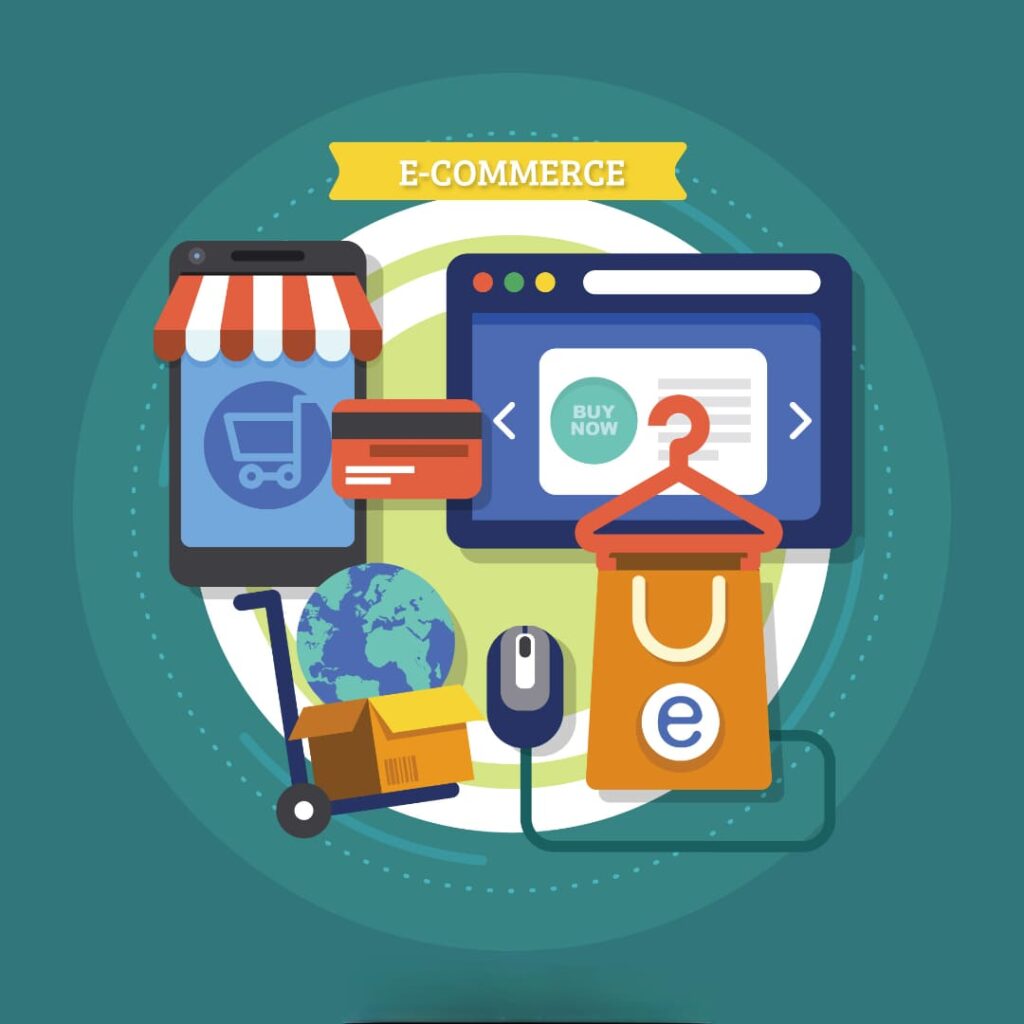
Step 5: Register Your Business
Registering your business is one of the most critical things you can do to make it official and make sure it stays legal. It establishes your credibility, safeguards your personal assets, and enables access to essential resources such as business funding and tax benefits. To begin, do the following:
1. Choose a Business Structure
Choose how your firm will be legally set up. Some common choices are:
- Sole Proprietorship: Simple to start, but doesn’t insulate you from personal liability.
- Partnership: Best for businesses with more than one owner that want to share profits and duties.
- Limited liabilities Company (LLC): Protects you from liabilities and gives you tax options.
- Corporation: Best for big companies that want to get investors since it offers the best protection from liability.
2. Register Your Business Name
Make sure that the name you choose for your firm is unique and easy to remember. Sign up with the right government agency, like the Registrar of Companies (ROC) or the equivalent in your nation.
3. Obtain Necessary Licenses and Permits
You may require certain licenses or permits to run your business legally, depending on where you are and what you do. Look into the rules for your area, state, and country to avoid problems with compliance.
4. Get an Employer Identification Number (EIN)
For tax purposes, you’ll usually require an EIN (or tax identification number). It is also crucial for employee onboarding and establishing a dedicated business bank account.
5. Open a Business Bank Account
Set up a dedicated business bank account to clearly separate your personal finances from your business transactions. This helps you keep track of your money, establish your credit, and make taxes easier to do.
6. Comply with Tax Regulations
Know what taxes you have to pay, like sales tax, income tax, and other taxes that apply. Consult a tax expert to ensure you comply with regulations and receive the greatest deductions.
Not only does registering your business make it legal, but it also opens the door to expansion. You set the groundwork for a successful business by taking care of the legal and financial requirements right away.
Step 6 :Build Your Store
To give customers a smooth buying experience, you need to make sure your online business is well-designed and works. This is where your brand comes to life and customers use your items. This is how to set up your store the right way.
- Set up basic store information
- Add your products
- Create informational pages
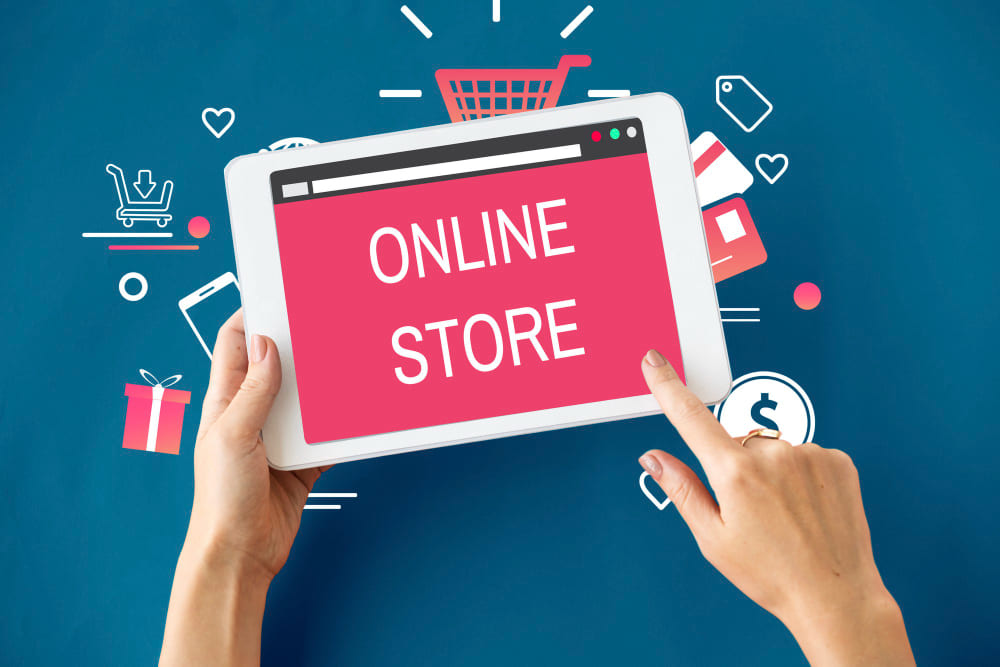
Step 7 : Simplifying the Path to Purchase
Simplify checkout and speed up shipping to enhance the shopping experience and build trust. This is how to do it right:
1. Streamline the Checkout Process
Let guests check out as guests to make the procedure smoother. This will make it easy for people who are buying for the first time and cut down on the number of steps needed to finish a transaction. You might get more sales with a one-page checkout. You should allow them to pay in numerous ways, like using credit cards, PayPal, or digital wallets like Apple Pay or Google Pay. Use SSL encryption and trust badges to make sure that transactions are safe. Finally, make the checkout procedure easier to use on mobile devices, since a lot of consumers want to shop on the go.
2. Optimize Shipping Options
Let customers choose how they want their order delivered, such as standard or expedited shipping. Whenever possible, provide alternatives such as local delivery or in-store pickup to enhance convenience for your customers. Make sure that the shipping charges are obvious from the start so that clients don’t encounter any surprises at checkout that can make them quit their cart. Put in real-time tracking systems so that clients can see where their things are at all times. Clearly communicate shipping policies, including delivery times and any restrictions, for both local and international orders.
3. Automate Where Possible
Build an ecommerce site from scratch that makes people feel welcome, clearly tells them what you have to offer, and motivates them to take action. You can use the About page to share your own story and connect with clients on a personal level by sharing your journey, values, and mission. To develop trust, be upfront about your shipping, refund, and privacy policies. Having a fun Contact page can make it easier for people to receive help. Last but not least, develop a thorough FAQ page that addresses common questions before they come up. This will improve the client’s experience and give them replies quickly.
4. Prioritize Returns and Customer Support
To build confidence with customers, make sure your return and exchange policies are straightforward and easy to follow, with clear instructions and due dates. Also, make sure that customers can simply and swiftly receive support with any shipping or checkout issues using chat, email, or phone.
A well-organized checkout and delivery system can mean the difference between a sale and a cart that consumers don’t buy. Your clients will like shopping with you more if you put convenience, transparency, and security first.
Step 8 : Launch Your Store
Now that everything is all up, it’s time to make your online store live and tell everyone about it. Before launching, ensure every aspect of your site functions flawlessly, including navigation, product pages, checkout flow, and mobile responsiveness. This will make sure that users have a smooth experience. Ensure all links, buttons, and forms work flawlessly, and improve loading times to deliver an optimal user experience.
When your store is ready, let people know about the opening with a strong marketing plan. Use email campaigns, posts on social media, and advertising that are aimed at specific groups to reach your audience. To get people talking about your store and get first-time shoppers to come in, provide special launch deals or discounts. After the launch, keep a careful eye on how your store is doing. Get feedback from customers and make changes to make their experience better.
The launch marks the start of your journey, not its conclusion. Stay proactive, look at how well your store is doing, and change your plans to make your business expand.
Step 9 : Promote your brand and items
After you open your business, the next step is to make sure that the right individuals see your brand and products. To connect with your audience on social media, provide updates about your products, material made by users, and behind-the-scenes looks at your business. To reach their fans, work with people who are well-known in your field.
Marketing Strategies for Promoting Your Brand and Items
- Search Engine Optimization (SEO)
- Social Media Marketing
- Paid Advertising
- Email Marketing
- Content Marketing
- Influencer Collaborations
- Affiliate Marketing
- Customer Engagement
- Local Marketing
- Analytics and Optimization
Step 10 : Optimize Your Store
Continuously optimize your store to enhance user experience and maximize sales and conversions. Here are the key aspects to focus on:
- Enhance Performance: Optimize loading speed, use a CDN, and ensure mobile-friendliness.
- Improve UX: Simplify navigation, use clear CTAs, and ensure intuitive design.
- Refine Product Pages: Add detailed descriptions, high-quality images, and customer reviews.
- Leverage Analytics: Monitor user behavior, track key metrics, and run A/B tests.
- SEO Optimization: Use relevant keywords, optimize images with alt text, and create content.
- Streamline Checkout: Simplify steps, offer multiple payment methods, and ensure security.
- Retain Customers: Use loyalty programs, personalized emails, and retargeting ads.
Read About : How can hiring Shopify SEO experts help with increased sales?
Comparison of Essential Startup Costs for E-Commerce Platforms
| Feature | Shopify | WooCommerce | Wix eCommerce | Magento (Adobe Commerce) |
| Monthly Fees | $29–$299 | Free (with WordPress) | $27–$59 | Free (Open Source) |
| Hosting | Included | $5–$25+ | Included | $10–$500+ |
| Domain | Included or $10–$20 | $10–$20 annually | $10–$20 annually | $10–$20 annually |
| SSL Certificate | Included | Free or $50+ annually | Included | Free or $50+ annually |
| Themes/Templates | Free to $350 | Free to $200 | Included | Free to $1,000+ |
| Apps/Extensions | Free to $50+ per month | Free to $50+ per plugin | Free to $30+ per month | Free to $500+ per extension |
| Transaction Fees | 2.9% + $0.30 (Shopify Pay) | Gateway fees (e.g., Stripe) | Gateway fees (e.g., Stripe) | Gateway fees (varies) |
| Customization Costs | Minimal | Moderate (plugins/themes) | Minimal | High ($1,000–$10,000+) |
| Total Estimated Cost | $30–$400+ per month | $15–$300+ per month | $30–$100+ per month | $50–$1,000+ per month |
Read More About : How Much Does Shopify Website Development Cost?
Final Thoughts
In 2025, starting an online store will be a great way to get into the growing world of e-commerce. With the right strategies like identifying your audience, sourcing quality products, and leveraging robust platforms like Shopify you can create a brand that resonates and delivers value. To be successful in this fast-paced field for a long time, you need to stay ahead of trends, make sure your customers have the best possible experiences, and keep changing. It’s time to go into e-commerce and find your spot in the online market, whether you’re a new business owner or an experienced one.
Read About : The advantages of Shopify Store Development at Krishang Technolab
Krishang Technolab: Your Partner for Digital Growth and E-Commerce Excellence
Krishang Technolab is an expert in cutting-edge web development, digital marketing, and Shopify development services, offering tailored e-commerce solutions to businesses of all sizes. They bring new ideas and high standards to every project. By focusing on personalized tactics, seamless user experiences, and measurable outcomes, Krishang Technolab helps businesses expand online, increase conversions, and stay ahead of industry trends. As a trusted Shopify development company, they ensure your store stands out with custom designs, optimized functionality, and a customer-first approach. This strategy helps your brand distinguish itself in a competitive marketplace.
